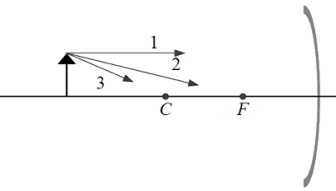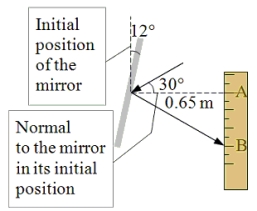A) +0.444 m, concave
B) +2.25 m, concave
C) +36.0 m. concave
D) +0.0278 m, convex
E) +36.0 m, convex
Correct Answer

verified
Correct Answer
verified
Multiple Choice
Which one of the following statements is not a characteristic of a plane mirror?
A) The image is real.
B) The magnification is +1.
C) The image is always upright.
D) The image is reversed right to left.
E) The image and object distances are equal in magnitude.
Correct Answer

verified
Correct Answer
verified
Multiple Choice
An object is placed in front of a concave spherical mirror as shown below. The three rays 1, 2, and 3, leave the top of the object and, after reflection, converge at a point on the top of the image. Ray 1 is parallel to the principal axis, ray 2 passes through F, and ray 3 passes through C.  -Which ray(s) will reflect back on itself (themselves) ?
-Which ray(s) will reflect back on itself (themselves) ?
A) 1 only
B) 2 only
C) 3 only
D) both 1 and 2
E) 1, 2, and 3
Correct Answer

verified
Correct Answer
verified
Multiple Choice
Makenzie walks directly toward a plane mirror at a speed of 0.30 m/s. Determine the speed of the image relative to her.
A) 0.15 m/s
B) 0.30 m/s
C) 0.60 m/s
D) 0.90 m/s
E) 1.2 m/s
Correct Answer

verified
Correct Answer
verified
Multiple Choice
The focal length of a spherical concave mirror is 25 cm. What is its radius of curvature?
A) 5 cm
B) 10 cm
C) 25 cm
D) 40 cm
E) 50 cm
Correct Answer

verified
Correct Answer
verified
Multiple Choice
A convex mirror has a radius of curvature of 0.50 m. Where must an object be placed in front of the mirror such that the image is formed 0.15 m behind the mirror?
A) 0.38 m
B) 0.19 m
C) 0.77 m
D) 0.093 m
E) 0.57 m
Correct Answer

verified
Correct Answer
verified
Multiple Choice
An object is placed 20 cm in front of a concave spherical mirror that has a radius of curvature 60 cm. Which one of the following phrases best describes the image?
A) virtual and located at infinity
B) real and located 60 cm from the mirror
C) real and located 120 cm from the mirror
D) virtual and located 60 cm from the mirror
E) virtual and located 120 cm from the mirror
Correct Answer

verified
Correct Answer
verified
Multiple Choice
A spherical concave mirror has a radius of curvature of 6.0 cm. At what distance from the mirror should a 6.0-cm object be placed to obtain an image that is 48 cm tall?
A) 1.3 cm
B) 3.6 cm
C) 4.2 cm
D) 5.3 cm
E) 6.8 cm
Correct Answer

verified
Correct Answer
verified
Multiple Choice
The view in the figure is from above a plane mirror suspended by a thread connected to the center of the mirror at point C. A scale is located 0.65 m (the distance from point C to point A) to the right of the center of the mirror. Initially, the plane of the mirror is parallel to the side of the scale; and the angle of incidence of a light ray which is directed at the center of the mirror is 30°. A small torque applied to the thread causes the mirror to turn 12° away from its initial position. The reflected ray then intersects the scale at point B. What is the distance from point A to point B on the scale? 
A) 0.37 m
B) 0.58 m
C) 0.76 m
D) 0.89 m
E) 1.0 m
Correct Answer

verified
Correct Answer
verified
Multiple Choice
A rubber ball is held 4.0 m above a concave spherical mirror with a radius of curvature of 1.5 m. At time equals zero, the ball is dropped from rest and falls along the principal axis of the mirror. How much time elapses before the ball and its image are at the same location?
A) 0.30 s
B) 0.55 s
C) 0.63 s
D) 0.71 s
E) 0.90 s
Correct Answer

verified
Correct Answer
verified
Multiple Choice
An object is placed in front of a concave spherical mirror as shown below. The three rays 1, 2, and 3, leave the top of the object and, after reflection, converge at a point on the top of the image. Ray 1 is parallel to the principal axis, ray 2 passes through F, and ray 3 passes through C.  -Which one of the following groups of terms best describes the image?
-Which one of the following groups of terms best describes the image?
A) real, upright, enlarged
B) real, inverted, reduced
C) virtual, upright, enlarged
D) real, inverted, enlarged
E) virtual, inverted, reduced
Correct Answer

verified
Correct Answer
verified
Multiple Choice
An object with a height of 3.0-cm is placed 8.0 cm in front of a mirror. The virtual image is 4.0 cm further from the mirror when the mirror is concave than when it is planar. -Determine the focal length of the concave mirror.
A) 6.0 cm
B) 12 cm
C) 24 cm
D) 48 cm
E) 96 cm
Correct Answer

verified
Correct Answer
verified
Multiple Choice
The table below lists object and image distances for five objects placed in front of mirrors. For which one of the following cases is the image formed by a convex spherical mirror? 
A) ![]()
B) ![]()
C) ![]()
D) ![]()
E) ![]()
Correct Answer

verified
Correct Answer
verified
Multiple Choice
Which one of the following phrases most accurately describes the term wave front?
A) the surface of a plane mirror
B) the surface of a convex mirror
C) a surface upon which a wave is incident
D) a surface of constant phase within a wave
E) a surface that is parallel to the direction of wave propagation
Correct Answer

verified
Correct Answer
verified
Multiple Choice
A convex mirror in an amusement park has a radius of curvature of 3.00 m. A man stands in front of the mirror so that his image is half as tall as his actual height. At what distance must the man focus his eyes in order to see his image?
A) 2.25 m
B) 3.00 m
C) 4.50 m
D) 5.00 m
E) 6.75 m
Correct Answer

verified
Correct Answer
verified
Multiple Choice
Which one of the following phrases most accurately describes paraxial rays?
A) rays that pass through the principal focus
B) any rays that are parallel to the principal axis
C) rays that come to a focus on the principal axis
D) rays close to the principal axis and parallel to it
E) rays close to the principal axis, but not necessarily parallel to it
Correct Answer

verified
Correct Answer
verified
Multiple Choice
A concave mirror is found to focus parallel rays at a distance of 18 cm. Where is the image formed when an object is placed 6.0 cm in front of the mirror?
A) 11 cm in front of the mirror
B) 18 cm behind the mirror
C) 3.6 cm in front of the mirror
D) 9.0 cm behind the mirror
E) 9.0 cm in front of the mirror
Correct Answer

verified
Correct Answer
verified
Multiple Choice
Which one of the following statements concerning a convex mirror is true?
A) A convex mirror can form a real image.
B) A convex mirror must be spherical in shape.
C) The image produced by a convex mirror will always be inverted relative to the object.
D) A convex mirror produces a larger image than a plane mirror does for the same object distance.
E) The image a convex mirror produces is closer to the mirror than it would be in a plane mirror for the same object distance.
Correct Answer

verified
Correct Answer
verified
Multiple Choice
A concave mirror in an amusement park has a radius of curvature of 4.0 m. A child stands in front of the mirror so that she appears 3.0 times taller than her actual height. If the image is upright, how far is she standing from the mirror?
A) 1.1 m
B) 1.3 m
C) 2.8 m
D) 3.0 m
E) 4.5 m
Correct Answer

verified
Correct Answer
verified
Multiple Choice
An object is placed in front of a concave spherical mirror as shown below. The three rays 1, 2, and 3, leave the top of the object and, after reflection, converge at a point on the top of the image. Ray 1 is parallel to the principal axis, ray 2 passes through F, and ray 3 passes through C.  -Which ray(s) will pass through F after reflection?
-Which ray(s) will pass through F after reflection?
A) 1 only
B) 2 only
C) 3 only
D) both 1 and 2
E) 1, 2, and 3
Correct Answer

verified
Correct Answer
verified
Showing 21 - 40 of 43
Related Exams